
Leucadendron tinctum, the spicy conebush, is a flower-bearing shrub that belongs to the genus Leucadendron and forms part of the fynbos. The plant is native to the Western Cape, where it occurs in the Hex River Mountains up to Hottentots Holland Mountains and Langeberg. The shrub grows 1.3 m tall and bears flowers from July to August.
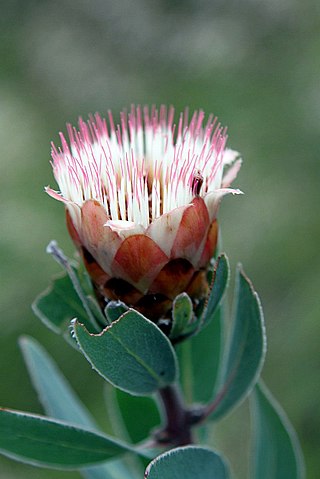
Protea subvestita, the waterlily sugarbush, is a flower bearing shrub that belongs to the well-known genus Protea. The plant is native to Lesotho and South Africa and occurs in Mpumalanga on the escarpment of the Wakkerstroom, Free State, KwaZulu-Natal, Eastern Cape, and the Klein Swartberg. The shrub is large, erect and grows up to 5 m. It flowers mainly from January to March.
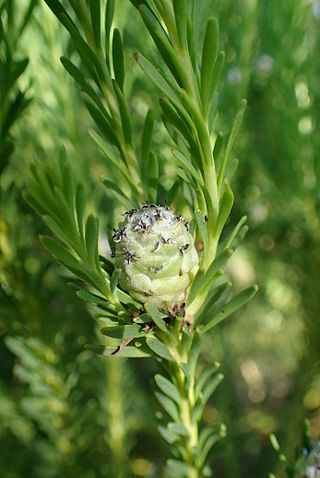
Leucadendron linifolium, the line-leaf conebush, is a flower-bearing shrub that belongs to the genus Leucadendron and forms part of the fynbos. The plant is native to the Western Cape, South Africa.
Leucadendron bonum, the Gideonskop conebush, is a flower-bearing shrub that belongs to the genus Leucadendron and forms part of the fynbos. The plant is native to the Western Cape, South Africa.

Leucadendron chamelaea, the Witsenberg conebush, is a flower-bearing shrub that belongs to the genus Leucadendron and forms part of the fynbos. The plant is native to the Western Cape, South Africa.

Leucadendron loeriense, the Loerie conebush, is a flower-bearing shrub that belongs to the genus Leucadendron and forms part of the fynbos. The plant is native to the Western Cape, where it is found in the Elandsberg, Baviaanskloof and Groot-Winterhoek mountains. The shrub grows 2.5 m tall and flowers in December and January.

Leucadendron rubrum, the spinning top, is a flower-bearing shrub belonging to the genus Leucadendron and forms part of the fynbos. The plant is native to the Western Cape, South Africa.

Leucadendron floridum, the flats conebush, is a flower-bearing shrub belonging to the genus Leucadendron and forms part of the fynbos. The plant is native to the Western Cape, where it occurs in the Cape Flats, from Rondebosch to Kuils River and also in the Cape Peninsula around most wetlands. The shrub grows 2 m tall and bears flowers from September to October.
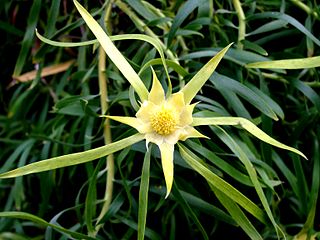
Leucadendron eucalyptifolium, the gum-leaved conebush, is a flower-bearing shrub belonging to the genus Leucadendron and forms part of the fynbos. The plant is native to the Western Cape and the Eastern Cape, where it occurs in the Potberg, Riversdal Plains, Langeberg, Outeniqua Mountains, Tsitsikamma Mountains, Kouga Mountains, Elandsberg, Swartberg, Waboomsberg, Warmwaterberg, Touwsberg, Rooiberg and Soetwaterberg. The shrub grows 4 m tall and bears flowers from July to October.
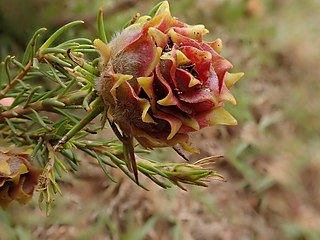
Leucadendron laxum, the Bredasdorp conebush, is a flower-bearing shrub belonging to the genus Leucadendron and forms part of the fynbos. The plant is native to the Western Cape, South Africa, where it occurs from Hermanus to Agulhas.
Serruria candicans, the shiny spiderhead, is a flower-bearing shrub that belongs to the genus Serruria and forms part of the fynbos. The plant is native to the Western Cape, where it occurs from Elandskloof to the Slanghoek Mountains and Paardeberg at Malmesbury. The shrub is erect and grows only 80 cm tall and bears flowers from July to December.

Serruria williamsii, commonly known as the king spiderhead, is a flower-bearing shrub that belongs to the genus Serruria and forms part of the fynbos. The plant is native to the Western Cape and only occurs in the Riviersonderend Mountains.

Leucadendron levisanus, commonly known as the Cape flats conebush, is a flower-bearing shrub that belongs to the genus Leucadendron and forms part of the fynbos. The plant is native to the Western Cape, where it occurs in the Cape Flats from Vishoek to Eerste River and Mamre. The shrub grows 2 m tall and bears flowers in October.
Dimorphotheca acutifolia is a plant belonging to the genus Dimorphotheca. The species is native to the Eastern and Western Cape Provinces.
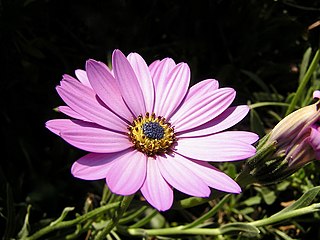
Dimorphotheca barberae is a plant belonging to the genus Dimorphotheca. The species is endemic to the Eastern Cape.
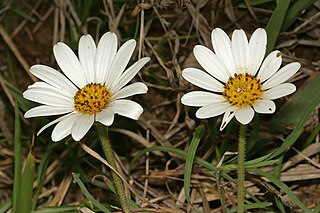
Dimorphotheca caulescens is a plant belonging to the genus Dimorphotheca. The species is endemic to the Eastern Cape, Western Cape and the Free State.
Berzelia cordifolia is a shrub that belongs to the Bruniaceae family. The species is endemic to the Western Cape and is part of the fynbos. The plant occurs from the Potberg in the De Hoop nature reserve to the Breede River estuary at Infanta. It has an area of occurrence of 150 km2 and there are eight subpopulations. The species is threatened by invasive plants and coastal development.

Clivia robusta is a plant and geophyte belonging to the genus Clivia. The species occurs in KwaZulu-Natal and the Eastern Cape from Pondoland and Port St. Johns to the uMzimkhulu River north of the Oribira Canyon and has an area of occurrence of 3,100 km2. There are currently less than ten subpopulations and the species has lost 30% of its habitat in the last 90 years due to overuse by traditional healers.
Erica amoena is a plant that belongs to the genus Erica and forms part of the fynbos. The plant is endemic to the Western Cape and occurs, among other things, in the Table Mountain National Park. The plant is considered rare.

Berzelia alopecuroides is a shrub that belongs to the Bruniaceae family. The species is endemic to the Western Cape and is part of the fynbos.















